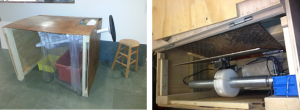Designers: Danielle Reinhardt, Greg Evans, Tim Carlon
Client Coordinator: John Wiltshire
Supervising Professors: Kevin Caves and Richard Goldberg
INTRODUCTION
OE Enterprises Inc. is a community rehabilitation program that employs individuals who have a range of disabilities. Our target clients are individuals who use a wheelchair, have effective use of only one hand, and may have other cognitive or physical disabilities. One job at OE involves preparing buckets of soil that are later sold to schools for science experiments. They start with a large pile of dirt on the floor of the OE facility. The job involves a three-step process: sieving dirt to make finer material, breaking up the remaining clumps to reduce waste, and scooping 8 pounds of the fine dirt into buckets. Currently, OE administrators complete the first step by shoveling dirt on top of a chicken wire pallet, which they then pick up and shake over a bin to create a finer material. This process requires both arms and significant strength. For the second step, they dispose of the remaining dirt clumps outside because they have no efficient way to break up these clumps. For the third step, our target clients have sufficient strength to scoop the dirt into small buckets. Our clients need a system that will allow them to complete the first two steps of this job: sieving dirt to make a finer material and breaking up clumps to reduce waste.

Figure 1: (a) The trommel device. Fine dirt is collected in the bin on the right, and the clumps fall through the end of the trommel into the bin on the left. (b) Overhead view of the jaw crusher device
STATEMENT OF IMPACT
The administration and clients at OE were very excited about the devices. We asked our client, Steve, about ease of use and he responded, “Oh yeah, it is very easy to use.” When he operated the trommel, he thought it was simple and efficient. He also liked that there were two safety switches for protection on the crusher. This dirt job is one that he was never able to do before, because of his limitations and he was very excited to be able to participate. Steve said with excitement to an administrator, “Another job for me?!” These devices will make the dirt job at OE easier and more efficient and will also allow clients in wheelchairs to complete this job.
DESIGN AND DEVELOPMENT
We created two devices that can be operated by our target clients: the trommel for sieving, and the jaw crusher to break up clumps. The trommel is a device operated manually by turning a wheel that rotates a cylindrical sieve. It is constructed from two plastic, 5 gallon buckets with the bottoms cut out. They are wrapped with metal wire mesh creating a tube. The tube is mounted in a PVC frame that allows it to be rotated. Dirt is loaded into one end of the trommel tube and when the wheel is turned, the dirt smaller than the 1/2” mesh size falls through the mesh into the collection buckets below. The trommel is tilted so that clumps too large to fit through the mesh fall out the far end of the tube, into a separate bucket. The entire device is enclosed in a box that helps to reduce the dust created by the sieving process.
The bucket of clumps is carried to a separate crushing device. The jaw crusher is comprised of two metal plates mounted onto a wooden frame. One plate is fixed to the frame and remains stationary, while the other is attached at a hinged joint. The metal plates are positioned so that only dirt less than 1⁄2” in diameter can get through the opening at the bottom. A conveyer belt motor with low speed and high torque turns a cam that presses against the moveable plate, causing a cyclical squeezing motion between the two plates. The clients open the crusher lid and pour in a scoop of clumps. When the lid is closed and the power turned on, the plates move back and forth, crushing larger clumps to a smaller size until they fall through the opening at the bottom and into a collection bin. There is a safety switch attached to the lid that prevents the crusher from operating until the lid is closed. The crusher is enclosed in a box that helps to reduce the dust created by crushing clumps.
The total cost of the trommel and jaw crusher devices is $305.
